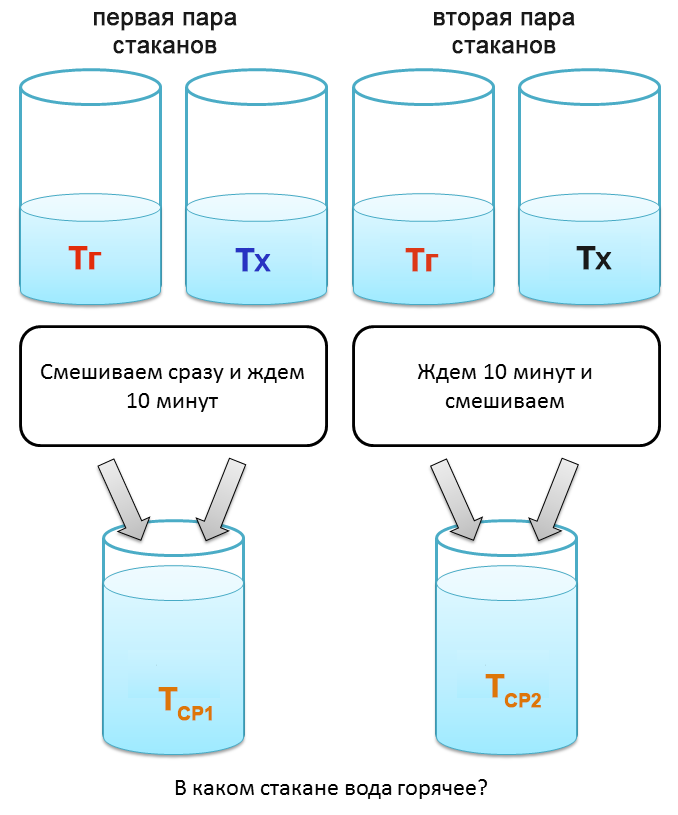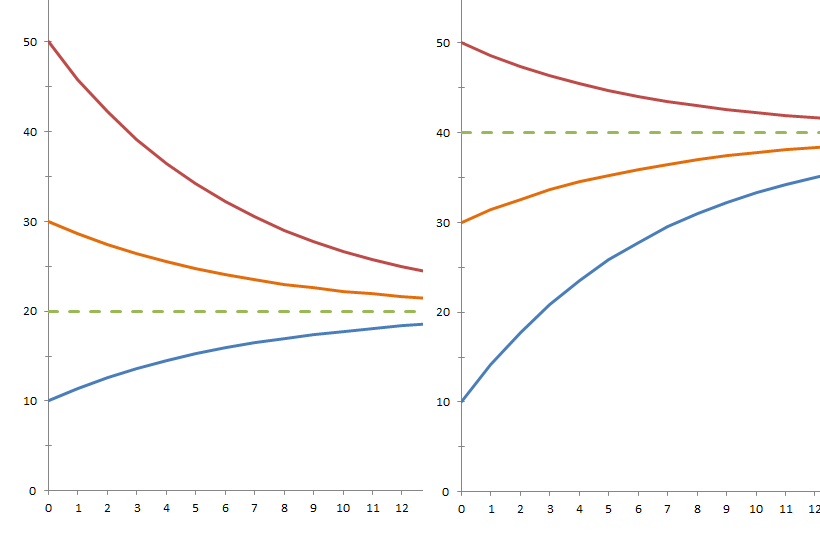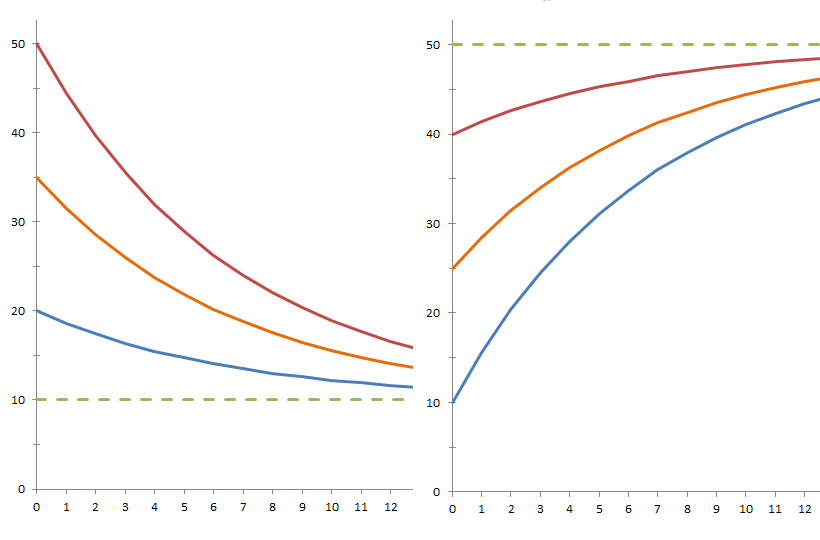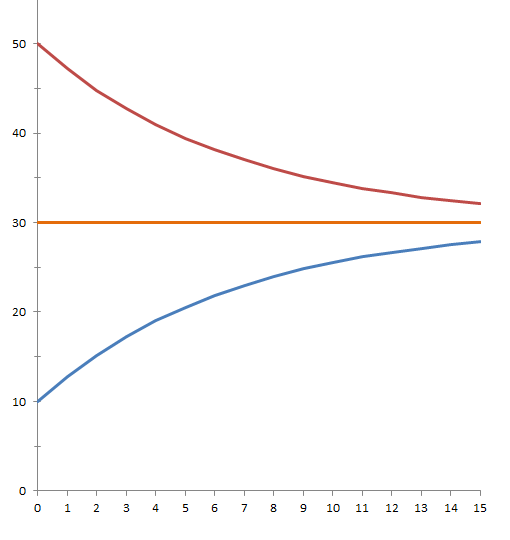Four glasses without formulas
In the wake of the “four glasses” or whether you need knowledge of the exact mathematical formulas of physical processes, or is there enough basic knowledge and reasoning logic.
Not only the whole rational human life (the key word is rational), but life in general strives to optimize vital processes. Note, not to minimize, but to optimization, i.e. to increase the so-called conditional process efficiency. Those. achieving results with minimal effort.
Having started reading the article “The Problem of Four Glasses”, I expected general reasoning and the appearance of formulas in a general form purely for illustration and clarity. However, the author decided to be punctually strict. Yes, he examined the problem and solved it quite nicely. However, the question arose of whether it can be solved correctly without resorting to specific formulas for describing a physical process? Solve, so to speak, on the fingers? Let's try. So (I repeat the initial, input data) we have two pairs of identical glasses, in each of which one glass is filled with “cold” water, the other is “hot”.
The essence of the experiment: mix water from the first pair and wait 10 minutes. Mix the water from the second pair of glasses. We measure the temperature of both mixtures of water. In which mixture will the temperature be higher / lower or will it be the same?

What is the main thing in such puzzle problems? The main thing is the phrase “all other things being equal”.
So, first of all, it is necessary to highlight unequal conditions. What are these conditions? This is the temperature of bodies and their volume-surface. What can be said about the physics and mathematics of the process? The cooling / heating rate of the body depends on:
1) The temperature difference between the heated / cooled body and the environment (this is physics);
2) The ratio of the volume and surface of bodies (this is physics);
3) And it has the form of an exponential (logarithmic) function (this is mathematics).
What is an exponential / logarithm change? This change is n-fold. What does it mean? This means that the measured parameter, regardless of its initial and “final” values, will change not “by”, but “by” a specific number of times depending on time (or another parameter / function argument).
Those. if one body has an initial temperature of 100 degrees, and the other 40 degrees, then, ceteris paribus, when the first body is cooled twice, it will have a temperature of 50 degrees, and the second will have a temperature of 20 degrees. It doesn’t even matter what degrees - in Kelvin or Celsius to measure - because the other conditions are equal.
The same dependence is demonstrated by the sound pressure level depending on the initial value (the role of temperature in our problem) and distance (the role of time in our problem).
I think readers will be able to supplement the list of "exponential" physical processes themselves. Those. with the physical nature of the "exponential" process, we clearly figured out. Leaving for now p. 2. out of consideration, we will look through the pictures of the options for the passage of the cooling / heating process.

Fig. 1 Designations


Fig. 2, 3. Variants of “asymmetric” initial temperatures.

Fig. 4. A variant of "symmetric" initial temperatures relative to ambient temperature.
So, we see (not in the pictures, but logically) that without considering item 2. the body temperature of the contents of the first pair of glasses will be equal to the temperature of the body of the contents of the second pair not only after a conditional 10 minutes, but also after any time.
We turn to item 2. We will talk about volume and surface, not mass, because the differences are in volume and surface. All other conditions are equal, as we recall. The amount of heat that the body gives / receives is proportional to the volume. The transmission resistance is proportional to the surface.
This means that the larger the surface-to-volume ratio, the faster the heat transfer process. The smaller the body, the faster it heats up / cools down (remember that the baby freezes in the cold faster than the adult? For this reason). Therefore, free-standing glasses - the second pair - will bring its temperature to ambient temperature faster. From a mathematical (and physical) point of view, this is tantamount to an increase in time.
If the temperatures of “cold” and “hot” water are equally distant from the ambient temperature, then the final temperatures of the mixtures will be equal. This, so to speak, is a “symmetric" option. If one of the initial temperatures “stands farther” from the ambient temperature, then due to a more intense heat exchange in a “separate” glass (second pair), it will quickly approach the ambient temperature and will no longer make its “full contribution” to preservation of the original state. Those. if “cold” water is “colder” than “hot” “hot”, then the second pair (due to the faster heat exchange process) will be warmer than the first pair of glasses. And vice versa.
So, without resorting to any mathematical formula, we were able to find the answer posed in the four-glass problem. Do you need formulas? Of course, if you need to calculate specific values.
“Education is what remains when everything learned is forgotten”Max von Laue, Burres Frederick Skinner, George Halifax, and possibly someone else.
Not only the whole rational human life (the key word is rational), but life in general strives to optimize vital processes. Note, not to minimize, but to optimization, i.e. to increase the so-called conditional process efficiency. Those. achieving results with minimal effort.
Having started reading the article “The Problem of Four Glasses”, I expected general reasoning and the appearance of formulas in a general form purely for illustration and clarity. However, the author decided to be punctually strict. Yes, he examined the problem and solved it quite nicely. However, the question arose of whether it can be solved correctly without resorting to specific formulas for describing a physical process? Solve, so to speak, on the fingers? Let's try. So (I repeat the initial, input data) we have two pairs of identical glasses, in each of which one glass is filled with “cold” water, the other is “hot”.
The essence of the experiment: mix water from the first pair and wait 10 minutes. Mix the water from the second pair of glasses. We measure the temperature of both mixtures of water. In which mixture will the temperature be higher / lower or will it be the same?

What is the main thing in such puzzle problems? The main thing is the phrase “all other things being equal”.
So, first of all, it is necessary to highlight unequal conditions. What are these conditions? This is the temperature of bodies and their volume-surface. What can be said about the physics and mathematics of the process? The cooling / heating rate of the body depends on:
1) The temperature difference between the heated / cooled body and the environment (this is physics);
2) The ratio of the volume and surface of bodies (this is physics);
3) And it has the form of an exponential (logarithmic) function (this is mathematics).
What is an exponential / logarithm change? This change is n-fold. What does it mean? This means that the measured parameter, regardless of its initial and “final” values, will change not “by”, but “by” a specific number of times depending on time (or another parameter / function argument).
Those. if one body has an initial temperature of 100 degrees, and the other 40 degrees, then, ceteris paribus, when the first body is cooled twice, it will have a temperature of 50 degrees, and the second will have a temperature of 20 degrees. It doesn’t even matter what degrees - in Kelvin or Celsius to measure - because the other conditions are equal.
The same dependence is demonstrated by the sound pressure level depending on the initial value (the role of temperature in our problem) and distance (the role of time in our problem).
I think readers will be able to supplement the list of "exponential" physical processes themselves. Those. with the physical nature of the "exponential" process, we clearly figured out. Leaving for now p. 2. out of consideration, we will look through the pictures of the options for the passage of the cooling / heating process.

Fig. 1 Designations


Fig. 2, 3. Variants of “asymmetric” initial temperatures.

Fig. 4. A variant of "symmetric" initial temperatures relative to ambient temperature.
So, we see (not in the pictures, but logically) that without considering item 2. the body temperature of the contents of the first pair of glasses will be equal to the temperature of the body of the contents of the second pair not only after a conditional 10 minutes, but also after any time.
We turn to item 2. We will talk about volume and surface, not mass, because the differences are in volume and surface. All other conditions are equal, as we recall. The amount of heat that the body gives / receives is proportional to the volume. The transmission resistance is proportional to the surface.
This means that the larger the surface-to-volume ratio, the faster the heat transfer process. The smaller the body, the faster it heats up / cools down (remember that the baby freezes in the cold faster than the adult? For this reason). Therefore, free-standing glasses - the second pair - will bring its temperature to ambient temperature faster. From a mathematical (and physical) point of view, this is tantamount to an increase in time.
If the temperatures of “cold” and “hot” water are equally distant from the ambient temperature, then the final temperatures of the mixtures will be equal. This, so to speak, is a “symmetric" option. If one of the initial temperatures “stands farther” from the ambient temperature, then due to a more intense heat exchange in a “separate” glass (second pair), it will quickly approach the ambient temperature and will no longer make its “full contribution” to preservation of the original state. Those. if “cold” water is “colder” than “hot” “hot”, then the second pair (due to the faster heat exchange process) will be warmer than the first pair of glasses. And vice versa.
So, without resorting to any mathematical formula, we were able to find the answer posed in the four-glass problem. Do you need formulas? Of course, if you need to calculate specific values.
